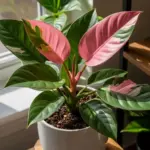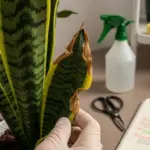3. Create the Ideal Humidity Environment Without Breaking the Bank

My apartment’s humidity was sitting at a crispy 25% when I first brought home my Monstera variegata. Within two weeks, those beautiful white sections started turning brown and crunchy.
I thought I was doing everything right – perfect light, careful watering, premium soil. Turns out, I was basically growing a tropical plant in the Sahara desert.
The humidity struggle is real, especially if you live somewhere with harsh winters or desert climates. But here’s the good news: you don’t need to spend hundreds on fancy equipment.
Understanding the 60-70% Humidity Sweet Spot
Optimal humidity levels for Monstera variegata fall between 60-70%, which sounds impossible when your home sits at 30% most of the year.
I bought a cheap hygrometer from Amazon for like $8 and started tracking humidity around my apartment. The numbers were depressing.
My bedroom was 22%, living room hit maybe 35% on a good day, and even my bathroom only reached 45% after hot showers.
But here’s what I learned: you don’t need to humidify your entire home. Microclimate creation is where the magic happens.
DIY Pebble Trays That Actually Work
This is probably the cheapest humidity hack that actually makes a difference. I use shallow plant saucers filled with pebbles and water under my plant pots.
The key is keeping the water level below the pebbles so your pot isn’t sitting in standing water. That’s a one-way ticket to root rot city.
I refresh the water every few days and clean the pebbles monthly to prevent algae buildup. Pebble tray humidity can boost the immediate area by 10-15%.
Pro tip: use decorative river rocks instead of plain pebbles. They look way better and work just as well.
Plant Grouping for Natural Humidity
I accidentally discovered this trick when I ran out of space and clustered all my plants together. Plant grouping creates its own little humid microenvironment.
Plants naturally release moisture through their leaves, so when you group them together, they basically help each other out.
My Monstera sits with my pothos, snake plant, and peace lily now. The humidity around that corner stays consistently 15-20% higher than the rest of my apartment.
Just make sure there’s still good air circulation to prevent fungal issues.
Budget-Friendly Humidifier Options
After trying every DIY trick in the book, I finally broke down and bought a humidifier. Best $35 I ever spent on my plant hobby.
Cool mist humidifiers work better than warm mist for plants, and they’re usually cheaper too. I got a basic 2-liter one that runs for about 12 hours.
Skip the fancy essential oil diffusers – plants don’t need aromatherapy, and some oils can actually harm them.
I run mine for 6-8 hours during the day, positioned about 3 feet from my plant cluster. It bumps the humidity up to that perfect 65% range.
Misting: The Right Way vs. The Wrong Way
Here’s where I made some expensive mistakes early on. Misting variegated leaves requires a completely different approach than regular green plants.
Those white sections have less chlorophyll and are more susceptible to water damage and fungal issues. I learned this after losing several beautiful leaves to brown spots.
Now I mist around the plant, not directly on the leaves. I spray the air above and around the plant, letting the mist settle naturally.
Fine mist sprayers work better than those chunky spray bottles that create big water droplets.
Strategic Bathroom and Kitchen Placement
This is probably my favorite free humidity hack. Bathroom humidity from showers can be a game-changer if you have the right light conditions.
My bathroom has a north-facing window, so I rotate my Monstera in there for a few hours after hot showers. It’s like a free spa day for plants.
Kitchen humidity from cooking works too, but be careful about grease and temperature fluctuations near the stove.
I’ve seen people permanently keep their plants in bathrooms, but most don’t have enough light for healthy variegation.
Affordable Humidity Monitoring Tools
That $8 hygrometer I mentioned earlier? Total game-changer. I actually bought three and placed them around different areas to track humidity variations.
Digital ones with min/max memory are worth the extra few bucks. You can see exactly how humidity changes throughout the day.
I check mine every morning with my coffee. It’s become part of my plant care routine, and it helps me adjust my humidifier schedule.
Consistent monitoring prevents those surprise humidity crashes that can stress your plant.
Seasonal Humidity Adjustments
Winter heating systems are humidity killers. I learned to crank up my humidity game from October through March when the furnace runs constantly.
Summer can be tricky too – air conditioning removes moisture from the air, so don’t assume warmer weather means better humidity.
I actually run my humidifier year-round now, just adjusting the frequency based on what my hygrometer tells me.
The investment in consistent humidity has paid off with bigger, more vibrant variegated leaves than I ever thought possible.
Ready to give your humidity-happy plant the perfect foundation to thrive? Click “next” to discover the soil mix recipe that’s produced the most stunning variegation I’ve ever seen – plus the fertilizer mistake that nearly killed my prize specimen (and how to avoid it)!









GIPHY App Key not set. Please check settings